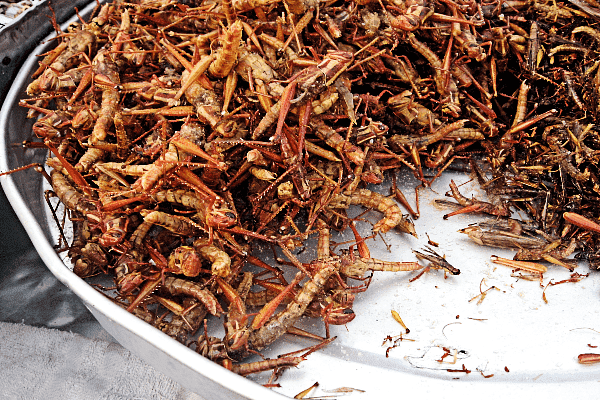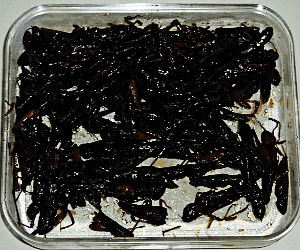 |
| Tips for knowing edible insects and their characteristics while surviving |
Tips for knowing edible insects and their characteristics when surviving in the wild. Eat insects to survive? It is highly recommended! To survive, we will definitely do anything, including eating insects.
Often, if we are faced with a survival scenario, what we always imagine is hunting big animals. But it is difficult and takes a long time. It's not as easy as in the movies, and we don't necessarily own or carry hunting gear.
Experienced survivalists, or those who actually practice survival science in real-life scenarios, will surely realize that it's easier to catch small animals like birds and insects than it is to hunt big ones.
Don't let us lose, we've wasted a lot of energy and calories to hunt big animals, but nothing, instead calories are wasted, you finally have no energy, and start to get hungry. In fact, around us, if we are observant, we will find many sources of food that are easily available, namely leaves, plants, and of course insects.
Tips for knowing edible insects and their characteristics while surviving, You Can Eat!
In fact, deep in the interior, far from modern information and technology, the interior tribes actually make insects as their mainstay menu and source of protein.
In fact, the Food and Agriculture Organization of the United Nations has released a report declaring insects as potential food for humans in the future. More than thousands of insect species have been documented as suitable for food globally. So, almost all kinds of insects we can eat.
In choosing insects as food for survival, there are several criteria that need to be considered, because like plants, not all insects are safe to eat. Here are the characteristics of edible insects:
1. Avoid flashy colored insects, Flashy colors in the wild can mean a warning to predators to stay away. Most of these brightly colored insects have poison or deadly secret weapons to defend themselves.
2. Avoid hairy insects, In general, insect hair contains toxins that can make you itchy and swollen which will make you very uncomfortable.
3. Avoid insects that smell bad, The smell is also a sign that this insect is secreting or spraying a liquid used for self-defense. This defensive liquid has a dangerous level of poison if consumed
4. Avoid insects that eat poisonous plants, Some types of snails eat poisonous plants, although the meat is safe to eat but the toxic content in the digestive system can cause problems for our bodies, to be safer and not at risk, should be avoided.
But if that's all they can eat then you can use tricks to drain their guts by collecting them and letting them starve for a few days or gathering them and feeding them non-toxic leaves.
Although some types of insects can be eaten raw, it is best to cook them before consumption because some types of insects have parasites. In addition, by cooking it, the taste is also much better, more savory and crunchy, there is no liquid that spouts when we bite it.
Types of Insects That Are Safe To Eat During Survival
It seems that survival is not for people who are picky eaters because to survive we must be willing to eat anything, including insects. Some forms of insects do give us goosebumps, but it turns out that there are a lot of benefits from eating insects.
 |
| Tips for knowing edible insects and their characteristics while surviving |
The Food and Agriculture Organization of the United Nations has released a report declaring insects as potential food for humans in the future. More than thousands of insect species have been documented as suitable for food globally. So, almost all kinds of insects we can eat.
Plus information from researchers at Kings College London researching the nutritional content of various insects. The research team analyzed the nutritional profiles of four insects: crickets and grasshoppers.
They found that crickets and beef had higher levels of iron, calcium, and magnesium. More importantly, crickets contain the most iron, even beating beef.
In addition, they also found that the copper, zinc, manganese, magnesium, and calcium content of crickets and grasshoppers were more available for absorption than the same nutrients in beef.
So what do you think about the results of this study? Besides being cheap, and available everywhere, insects have a lot of nutrients and are highly recommended to eat, not least in survival conditions where we have to survive from eating anything.
The following are insects that you can eat in a state of
survival:
1. Ants, The practice of eating ants already exists in various parts of the world with various recipes. This proves that ants can indeed be eaten.
But before eating ants, make sure the acid content in the ants is gone. This can be done by boiling the ants first, making sure the ants are dead before they are eaten. Acidic liquid will come out of the ants when threatened.
In the wild we can look for ants by following where groups of ants go looking for ant nests. Ant larvae in the nest do not contain acid and are the most palatable colonies to eat.
2. Grasshopper, The taste of this grasshopper is almost similar to the taste of shrimp. Make sure after getting the grasshoppers must be processed immediately, because if the dead grasshoppers are left too long, the color will turn yellow and taste bad, for sensitive ones it can cause diarrhea.
Hunt for locusts in the morning because they move slower. Look in the bushes, leaves and trees. It will be easier to catch it using an insect net. Before cooking, remove the head, remove the wings and legs. After that it can be baked or fried until dry.
3. Crickets, Similar to grasshoppers, crickets can be found on the ground or in small caves. You can also make a cricket trap by burying a plastic bottle in the ground and placing fruit or vegetable bait. The way to consume it is also the same, namely only eating the stomach.
4. Cockroach, Cockroaches can be consumed as long as the cockroach is cooked properly and it is ensured that the bacteria in the cockroach's body is gone before we eat it.
Remove the legs, wings and head as well as the liquid on the body and cook until completely dry. Forest cockroaches can be found in the remains of rotting trees, they are larger than house cockroaches.
5. Termites, These insects are very rich in protein, iron, calcium, and amino acids. Termite nests are found in forests and also in dead tree trunks. We can fry it or bake it until it is cooked.
6. Caterpillar larvae, We often see caterpillar larvae in adventure videos, eaten cooked or raw. Commonly eaten larvae are banana leaf larvae, certain tree wood larvae, etc. These larvae are very rich in protein. Although it can be eaten raw, it would be better if we cooked it first.
7. Bees and Wasps, Apart from using honey, we can also eat bees and wasps in an emergency. Bees are believed to be good for children to eat as they get older because of the nutritional content they have for growth. Not only that, when bees or wasps are still in the form of larvae and eggs, they are also commonly consumed like almonds.
8. Beetle, Beetles that are good for consumption are beetles that live in tropical forests. The physical characteristic of this beetle is to have long horns, live in trees or wood that falls to the ground. These beetles can convert cellulose from trees and digest it into fat that is easy for humans to digest.
9. Scorpion, We can find scorpions hiding in damp dark places such as crevices in rocks or dead tree trunks. Be careful when looking for it as you could get a poisonous sting. Be sure to remove the poison before grilling it.
Basically, almost any insect is edible as long as it is non-toxic and handled properly. The indication is, if the insect is food from another animal, then we can eat the insect. So when in a state of survival, we can survive by eating insects.
 |
| Tips for knowing edible insects and their characteristics while surviving |
That's my article about Tips for knowing edible insects and their characteristics when surviving in the wild, I hope it can help you when you are surviving in the wild in the future.







0 comments